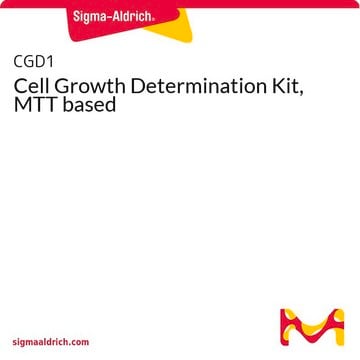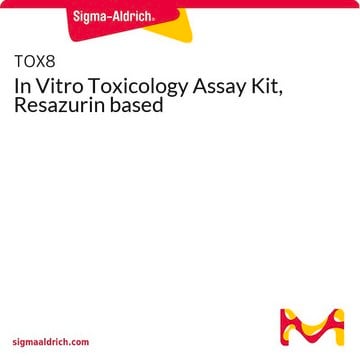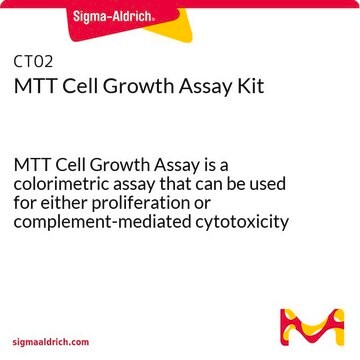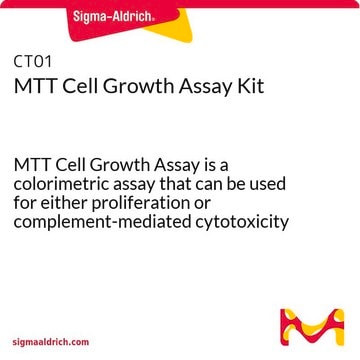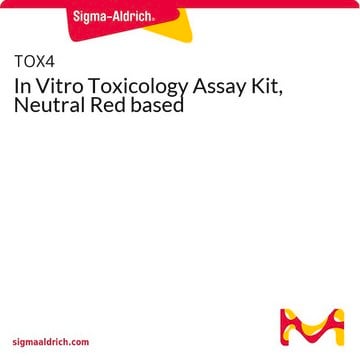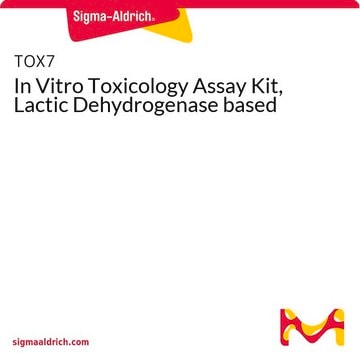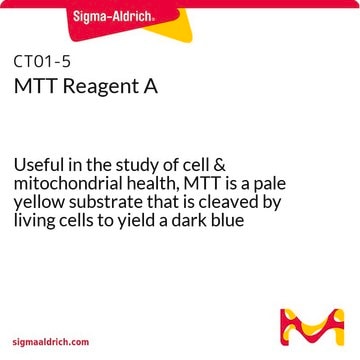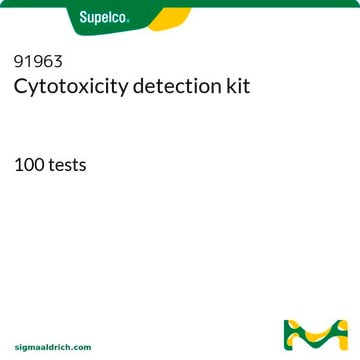TOX1
In Vitro Toxicology Assay Kit, MTT based
Synonym(s):
mitochondrial activity assay
Sign Into View Organizational & Contract Pricing
All Photos(1)
About This Item
UNSPSC Code:
12352207
NACRES:
NA.84
Recommended Products
usage
1 kit sufficient for 1,000 tests
packaging
pkg of 1 kit
storage condition
dry at room temperature
λmax
570 nm
application(s)
cell analysis
detection
detection method
colorimetric
storage temp.
2-8°C
General description
This kit is designed for determining cell number/ cell viability spectrophotometrically as a function of mitochondrial activity in living cells. The MTT method is simple, accurate and yields reproducible results. The key component is (3- [4,5- dimethylthiazol-2-yl]-2,5-diphenyl tetrazolium bromide) or MTT. Solutions of MTT, dissolved in medium or balanced salt solutions without phenol red, are yellowish in color. Mitochondrial dehydrogenases of viable cells cleave the tetrazolium ring, yielding purple formazan crystals which are insoluble in aqueous solutions. Absorbance of converted dye is measured at a wavelength of 570nm.
Application
In Vitro Toxicology Assay Kit, MTT based has been used to perform an (3-[4,5-dimethylthiazole-2-yl]-2,5-diphenyltetrazolium bromide) MTT assay to measure the cytotoxicity of gold nanoparticles (AuNP). It has also been used to examine cell viability in SH-SY5Y cultures in response to 6-hydroxydopamine (6-OHDA) treatment.
Biochem/physiol Actions
Conversion of MTT to a water-insoluble colored formazan derivative which is then solubilized in acidic isopropanol.
related product
Product No.
Description
Pricing
Signal Word
Danger
Hazard Statements
Precautionary Statements
Hazard Classifications
Aquatic Acute 1 - Aquatic Chronic 2 - Eye Dam. 1 - Flam. Liq. 2 - Muta. 2 - Skin Corr. 1 - STOT SE 3
Target Organs
Central nervous system, Respiratory system
Storage Class Code
3 - Flammable liquids
Flash Point(F)
53.6 °F
Flash Point(C)
12 °C
Choose from one of the most recent versions:
Already Own This Product?
Find documentation for the products that you have recently purchased in the Document Library.
Customers Also Viewed
Human renal organic anion transporter 1-dependent uptake and toxicity of mercuric-thiol conjugates in Madin-Darby canine kidney cells
Aslamkhan AG, et al.
Molecular Pharmacology, 63(3), 590-596 (2003)
Dalia Chávez-García et al.
Journal of biomedical materials research. Part B, Applied biomaterials, 108(6), 2396-2406 (2020-02-06)
Luminescent lanthanide downconversion nanoparticles (DCNPs) provide a combination of high luminescence intensity, sharp emission peaks with narrow bandwidth and a large Stokes' shift, leading to high-performance biomedical applications mainly for imaging. The purpose of this study is to present a
J Carmichael et al.
Cancer research, 47(4), 936-942 (1987-02-15)
Drug sensitivity assays were performed using a variation of a colorimetric [3-(4,5-dimethylthiazol-2-yl)-2,5-diphenyltetrazolium bromide (MTT)] assay on V79, CHO-AuxB1, CHRC5, NCI-H460, and NCI-H249 cell lines following optimization of experimental conditions for each cell line. Results from this assay were compared with
Jun Wang et al.
Molecular therapy : the journal of the American Society of Gene Therapy, 17(2), 343-351 (2008-12-11)
Spliceosome-mediated RNA trans-splicing has emerged as an exciting mode of RNA therapy. Here we describe a novel trans-splicing strategy, which targets highly abundant pre-mRNAs, to produce therapeutic proteins in vivo. First, we used a pre-trans-splicing molecule (PTM) that mediated trans-splicing
T Mosmann
Journal of immunological methods, 65(1-2), 55-63 (1983-12-16)
A tetrazolium salt has been used to develop a quantitative colorimetric assay for mammalian cell survival and proliferation. The assay detects living, but not dead cells and the signal generated is dependent on the degree of activation of the cells.
Our team of scientists has experience in all areas of research including Life Science, Material Science, Chemical Synthesis, Chromatography, Analytical and many others.
Contact Technical Service